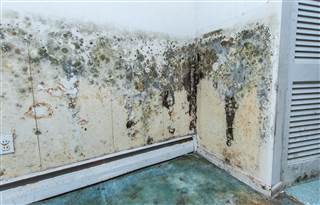OK – I am not really sure how much of this is new, but a new paper in AEM is getting some press recently.
I first found out about it via a Tweet from Elisabeth Bik
Wallpaper May Breed Toxins: Study
Wallpaper may contribute to “sick building syndrome,”https://t.co/GdVUNBCYha— Elisabeth Bik (@MicrobiomDigest) June 25, 2017
Sick Building Syndrome: Fungi Can Squirt Toxins Directly Into Air, Study Finds
Source: This mold study may help explain some causes of sick building syndrome. By Maggie Fox.
Basically what appears to be new is the following:
The team first grew the three fungi on ordinary wallpaper, and then tested to see if the toxins they produce could get into the air without some sort of interference, such as tearing down walls.
“We demonstrated that mycotoxins could be transferred from a moldy material to air, under conditions that may be encountered in buildings,” Bailly said in a statement.
This is not really my area of expertise so maybe other people who work on this topic or related topics can chime in.
Link to the paper: Aerosolization of mycotoxins after growth of toxinogenic fungi on wallpaper

Jonathan thanks for sharing this paper about fungal growth on wallpaper and release of mycotoxins on particles. It is always great to see new studies of fungal growth in the indoor environment. This paper focuses only on mycotoxins that partition onto particles (not including other more volatile mycotoxins).
I’m curious to hear others’ thoughts on this paper as well. I think it provides some interesting and important data about partitioning of mycotoxins into different particle size fractions upon aerosolization. I appreciate that it is framed as a precursor to risk assessment. From the data it seems like the contribution to human exposure would likely be fairly low due to high air velocities (2 m/s) needed to suspend substantial numbers of particles. This is consistent with other work (see for instance http://www.sciencedirect.com/science/article/pii/S1352231009003641). It is fairly clear from the literature that visible mold growth on wallpaper needs to be remediated to prevent negative effects on human health, but the question remains if the link to those health effects is through mycotoxins on particles and/or potentially other exposures.
Thanks for prompting a discussion, Karen. I have a couple of thoughts: (1) Do any of these species actively launch spores into air, as with one fungal plant pathogen I have studied? (2) Due to my own ignorance, I had thought that mycotoxins were mostly volatile organic compounds (VOCs), but the ones identified in the paper have very low vapor pressures and will be found mainly in the condensed phase (i.e., adsorbed to surfaces such as particles). Thus, exposure requires aerosolization of mycotoxin-containing particles, as emphasized in the study. Now I’m intrigued!
I’m going to jump into the discussion here. One of the most interests aspects of the paper for me was seeing the bimodal distribution of particles that were released: the micron size that we typically measure (2-7µm) but also ultra fine particles. I tend to think of particles the size of spores or fungal fragments, so it was cool to be reminded of other exposure routes.
There’s been some work, as Karen pointed out, on the release of particles from moldy building materials under different environmental conditions, but this was the first study I know of that looked at mycotoxins specifically in those particles. Linsey, to your second point, there have been a few other reports of fungal particles, some smaller than conidia, containing mycotoxins (https://www.ncbi.nlm.nih.gov/pubmed/19757292; https://www.ncbi.nlm.nih.gov/pmc/articles/PMC544211/).
I keep going back to the air velocities they used. The 2 or 6 m/s that they used to generate appreciable aerosols from wallpapers were quite high (again, as Karen mentioned). One study (http://www.sciencedirect.com/science/article/pii/0160412089900743) that did a survey of air velocities in a small number of home reported a median value of 7.2 cm/s and a max of 57 cm/s. Another study found that a fan operating at high power placed at a distance of 1 m from the target generated air velocities of 2 m/s (http://www.sciencedirect.com/science/article/pii/S0360132314004041). To Linsey’s first point – Aspergillus and Penicillium disperse their spores through passive means, getting airborne through wind or physical disturbance. Stachy spores are known to be heavy and sticky, and it makes sense that those spores required higher air velocities than Aspergillus and Penicillium. I think all these points speak to how often the air velocities where this and other studies detected aerosolization would arise in typical homes and therefore how impactful is this particular exposure route. Perhaps even occasional gusts in the indoor environments could have an impact.
I thought this was very interesting. Would be very curious to learn more about it! Thank you for sharing!